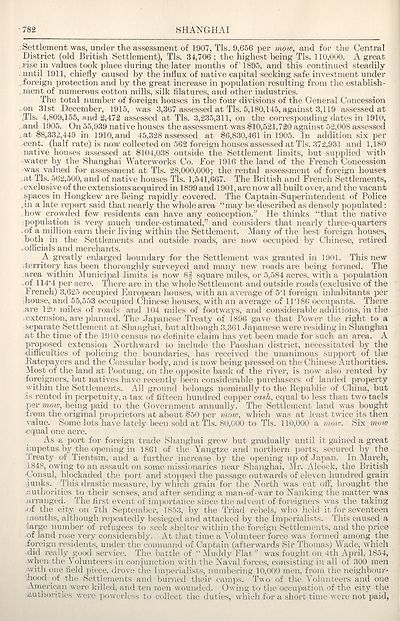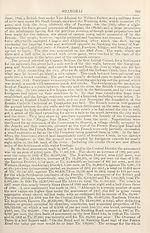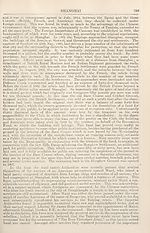1917
(880) Page 782
Download files
Complete book:
Individual page:
Thumbnail gallery: Grid view | List view

SHANGHAI
^Settlement was, under the assessment of 1907, Tls. 9,656 per mow, and for the Central
District (old British Settlement), Tls. 34,706 ; the highest being Tls. 110,000. A great
; rise in values took place during the later months of* 1895, and this continued steadily
until 1911, chiefly caused by the influx of native capital seeking safe investment under
. foreign protection and by the great increase in population resulting from the establish-
, mcnt of numerous cotton mills, silk filatures, and other industries.
The total number of foreign houses in the four divisions of the General Concession
• on 31st December, 1915, was 3,367 assessed at Tls. 5,180,145, against 3,119 assessed at
.Tls. 4,809,155, and 2,472 assessed at Tls. 3,235,311, on the corresponding dates in 1910,
. and 1905. On 55,939 native houses the assessment was $10,521,720 against 52,008 assessed
. at $8,332,449 in 1910, and 45,328 assessed at $6,830,461 in 1905. In addition six per
.cent, (half rate) is now collected on 562 foreign houses assessed at Tls. 372,931 and 1,180
native houses assessed at $104,038 outside the Settlement limits, but supplied with
water by the Shanghai Waterworks Co. For 1916 the land of the French Concession
-was valued for assessment at Tls. 28,000,000; the rental assessment of foreign houses
at Tls. 562,500, and of native houses Tls. 1,541,667. The British and French Settlements,
. exclusive of the extensions acquired in 1899 and 1901, are now all built over, and the vacant
spaces in Hongkew are being rapidly covered. The Captain-Superintendent of Police
.in a late report said that nearly the whole area “may be described as densely populated:
how crowded few residents can have any conception.” He thinks “that the native
population is very much under-estimated,” and considers that nearly three-quarters
• of a million earn their living within the Settlement. Many of the best foreign houses,
both in the Settlements and outside roads, are now occupied by Chinese, retired
. officials and merchants.
A greatly enlarged boundary for the Settlement was granted in 1901. This new
.territory has been thoroughly surveyed and many new roads are being formed. The
area within Municipal limits is now 8f square miles, or 5,584 acres, with a population
• of 114'4 per acre. There are in the whole Settlement and outside roads (exclusive of the
French) 3,625 occupied European houses, with an average of 5'l foreign inhabitants per
,house, and 55,553 occupied Chinese houses, with an average of 11T86 occupants. There
are 120 miles of roads and 104 miles of footways, and considerable additions, in the
.extension, are planned. The Japanese Treaty of 1896 gave that Power the right to a
separate Settlement at Shanghai, but although 3,361 Japanese were residing in Shanghai
at the time of the 1910 census no definite claim has yet been made for such an area. A
proposed extension Northward to include the Paoshan district, necessitated by the
difficulties of policing the boundaries, has received the unanimous support of the
Batepayers and the Consular body, and is now being pressed on the Chinese Authorities.
Most of the land at Pootung, on the opposite bank of the river, is now also rented by
•foreigners, but natives have recently been considerable purchasers of landed property
within the Settlements. All ground belongs nominally to the Bepublic of China, but
is rented in perpetuity, a tax of fifteen hundred copper cash, equal to less than two taels
per moiv, being paid to the Government annually. The Settlement land was bought
-from the original proprietors at about $50 per mow, which was at least twice its then
value. Some lots have lately been sold at Tls. 80,000 to Tls. 110,000 a moio. Six mow
equal one acre.
As a port for foreign trade Shanghai grew but gradually until it gained a great
impetus by the opening in 1861 of the Yangtze and northern ports, secured by the
Treaty of Tientsin, and a further increase by the opening up of Japan. In March,
1848, owing to an assault on some missionaries near Shanghai, Mr. Alcock, the British
■Consul, blockaded the port and stopped the passage outwards of eleven hundred grain
junks. This drastic measure, by which grain for the North was cut off, brought the
authorities to their senses, and after sending a man-of-war to Nanking the matter was
arranged. The first event of importance since the advent of foreigners was the taking
of the city on 7th September, 1853, by the Triad rebels, who held it for seventeen
months, although repeatedly besieged and attacked by the Imperialists. This caused a
large number of refugees to seek shelter within the foreign Settlements, and the price
of land rose very considerably. At that time a Volunteer force was formed among the
foreign residents, under the command of Captain (afterwards Sir Thomas) Wade, which
did really good service. The battle of “Muddy Flat” was fought on 4th April, 1854,
when the Volunteers in conjunction with the Naval forces, consisting in all of 300 men
with one field piece, drove the Imperialists, numbering 10,000 men, from the neighbour¬
hood of the Settlements and burned their camps. Two of the Volunteers and one
American were killed, and ten men wounded. Owing to the occupation of the city the
authorities were powerless to collect the duties, which for a short time were not paid,
^Settlement was, under the assessment of 1907, Tls. 9,656 per mow, and for the Central
District (old British Settlement), Tls. 34,706 ; the highest being Tls. 110,000. A great
; rise in values took place during the later months of* 1895, and this continued steadily
until 1911, chiefly caused by the influx of native capital seeking safe investment under
. foreign protection and by the great increase in population resulting from the establish-
, mcnt of numerous cotton mills, silk filatures, and other industries.
The total number of foreign houses in the four divisions of the General Concession
• on 31st December, 1915, was 3,367 assessed at Tls. 5,180,145, against 3,119 assessed at
.Tls. 4,809,155, and 2,472 assessed at Tls. 3,235,311, on the corresponding dates in 1910,
. and 1905. On 55,939 native houses the assessment was $10,521,720 against 52,008 assessed
. at $8,332,449 in 1910, and 45,328 assessed at $6,830,461 in 1905. In addition six per
.cent, (half rate) is now collected on 562 foreign houses assessed at Tls. 372,931 and 1,180
native houses assessed at $104,038 outside the Settlement limits, but supplied with
water by the Shanghai Waterworks Co. For 1916 the land of the French Concession
-was valued for assessment at Tls. 28,000,000; the rental assessment of foreign houses
at Tls. 562,500, and of native houses Tls. 1,541,667. The British and French Settlements,
. exclusive of the extensions acquired in 1899 and 1901, are now all built over, and the vacant
spaces in Hongkew are being rapidly covered. The Captain-Superintendent of Police
.in a late report said that nearly the whole area “may be described as densely populated:
how crowded few residents can have any conception.” He thinks “that the native
population is very much under-estimated,” and considers that nearly three-quarters
• of a million earn their living within the Settlement. Many of the best foreign houses,
both in the Settlements and outside roads, are now occupied by Chinese, retired
. officials and merchants.
A greatly enlarged boundary for the Settlement was granted in 1901. This new
.territory has been thoroughly surveyed and many new roads are being formed. The
area within Municipal limits is now 8f square miles, or 5,584 acres, with a population
• of 114'4 per acre. There are in the whole Settlement and outside roads (exclusive of the
French) 3,625 occupied European houses, with an average of 5'l foreign inhabitants per
,house, and 55,553 occupied Chinese houses, with an average of 11T86 occupants. There
are 120 miles of roads and 104 miles of footways, and considerable additions, in the
.extension, are planned. The Japanese Treaty of 1896 gave that Power the right to a
separate Settlement at Shanghai, but although 3,361 Japanese were residing in Shanghai
at the time of the 1910 census no definite claim has yet been made for such an area. A
proposed extension Northward to include the Paoshan district, necessitated by the
difficulties of policing the boundaries, has received the unanimous support of the
Batepayers and the Consular body, and is now being pressed on the Chinese Authorities.
Most of the land at Pootung, on the opposite bank of the river, is now also rented by
•foreigners, but natives have recently been considerable purchasers of landed property
within the Settlements. All ground belongs nominally to the Bepublic of China, but
is rented in perpetuity, a tax of fifteen hundred copper cash, equal to less than two taels
per moiv, being paid to the Government annually. The Settlement land was bought
-from the original proprietors at about $50 per mow, which was at least twice its then
value. Some lots have lately been sold at Tls. 80,000 to Tls. 110,000 a moio. Six mow
equal one acre.
As a port for foreign trade Shanghai grew but gradually until it gained a great
impetus by the opening in 1861 of the Yangtze and northern ports, secured by the
Treaty of Tientsin, and a further increase by the opening up of Japan. In March,
1848, owing to an assault on some missionaries near Shanghai, Mr. Alcock, the British
■Consul, blockaded the port and stopped the passage outwards of eleven hundred grain
junks. This drastic measure, by which grain for the North was cut off, brought the
authorities to their senses, and after sending a man-of-war to Nanking the matter was
arranged. The first event of importance since the advent of foreigners was the taking
of the city on 7th September, 1853, by the Triad rebels, who held it for seventeen
months, although repeatedly besieged and attacked by the Imperialists. This caused a
large number of refugees to seek shelter within the foreign Settlements, and the price
of land rose very considerably. At that time a Volunteer force was formed among the
foreign residents, under the command of Captain (afterwards Sir Thomas) Wade, which
did really good service. The battle of “Muddy Flat” was fought on 4th April, 1854,
when the Volunteers in conjunction with the Naval forces, consisting in all of 300 men
with one field piece, drove the Imperialists, numbering 10,000 men, from the neighbour¬
hood of the Settlements and burned their camps. Two of the Volunteers and one
American were killed, and ten men wounded. Owing to the occupation of the city the
authorities were powerless to collect the duties, which for a short time were not paid,
Set display mode to:
![]() Universal Viewer |
Universal Viewer | ![]() Mirador |
Large image | Transcription
Mirador |
Large image | Transcription
Images and transcriptions on this page, including medium image downloads, may be used under the Creative Commons Attribution 4.0 International Licence unless otherwise stated. ![]()
| Asian directories and chronicles > 1917 > (880) Page 782 |
|---|
| Permanent URL | https://digital.nls.uk/194543748 |
|---|
| Attribution and copyright: |
|
|---|---|
| Description | Volumes from the Asian 'Directory and Chronicle' series covering 1917-1941, but missing 1919 and 1923. Compiled annually from a multiplicity of local sources and research. They provide listings of each country's active corporations, foreign residents and government agencies of all nationalities for that year, together with their addresses. Content includes: various treaties; coverage of conflicts; currencies and taxes; consular fees; weights and measures; public holidays; festivals and traditions. A source of information for both Western states and communities of foreigners living in Asia. Published by Hongkong Daily Press. |
|---|---|
| Shelfmark | H3.86.1303 |
| Additional NLS resources: |

